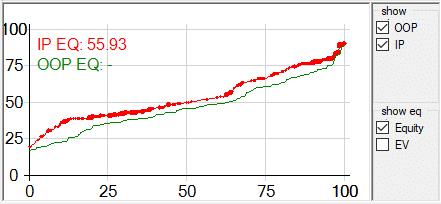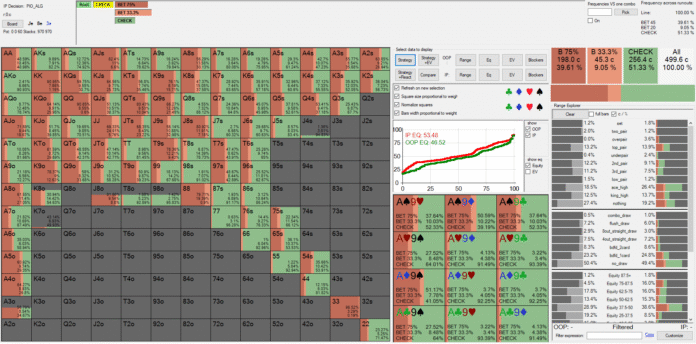Through the years, I’ve largely centered on methods to play because the aggressor, significantly on the flop. That stage is crucial as a result of it units the muse for every little thing that follows.
On this article, nonetheless, we’ll shift focus to conditions the place your opponent has handed on the possibility to wager.
These spots are wealthy with alternative to spice up your anticipated worth, but they’re usually misplayed—even on the highest ranges on-line. Whereas I’ll primarily talk about methods to method arms when your opponent skips a continuation wager, the identical ideas apply when he provides up his probability to stab.
Let’s dive in.
Why Is This Spot a Nice Alternative To Enhance Your Win-rate?
The explanation these spots current such a powerful alternative to extend your EV is straightforward: taking part in an efficient c-betting technique in place is troublesome and simple to get incorrect. Even expert gamers usually create imbalances on later streets which might be laborious to right—generally even after they acknowledge the problem.
As talked about earlier, the flop is the cornerstone of a successful technique. This isn’t simply because you possibly can generate a number of worth there (although you generally can), however extra importantly as a result of sturdy flop play protects you from dropping worth by being exploited on the flip.
Your objectives are twofold: exploit your opponent’s errors whereas avoiding being exploited your self. These aims are sometimes in pressure, and which one takes precedence relies upon largely in your opponent’s potential to acknowledge and capitalize by yourself imbalances.
Within the following sections, I’ll present you methods to shift your focus towards your opponent and punish weaknesses of their flop c-betting technique.
What Goes Fallacious?
There are three fundamental areas the place gamers can go incorrect:
- Betting frequency
- Wager sizing
- Vary composition
Each participant makes errors in these areas to some extent, with the specifics relying on their talent degree. For the needs of this text, nonetheless, vary composition is crucial—and that’s what we’ll concentrate on subsequent.
Vary Composition Mistake #1: Betting Too Many Robust Palms
That is in all probability the most typical mistake you’ll encounter as a result of it ties on to considered one of our core human biases: danger aversion.
Threat aversion is the pure tendency to keep away from conditions that really feel harmful or unsure. From an evolutionary standpoint, individuals who leaned towards danger aversion have been extra prone to survive and reproduce. Those that sampled the unknown berry, touched the toxic snake, or took different reckless dangers usually didn’t dwell lengthy sufficient to move on their genes.
Utilized to poker, this bias usually manifests as a risk-averse technique: investing cash solely when holding a powerful probability of successful—in different phrases, betting primarily with high-equity arms (together with sturdy attracts).
At first look, this appears affordable. However in opposition to an attentive opponent with sample recognition, it shortly backfires. As soon as they discover you’re solely betting sturdy arms, they’ll cease paying off with their weaker holdings and should even ramp up aggression to use your predictability. That’s precisely the type of mistake this text will assist you to capitalize on.
The clearest option to clarify is with an instance. One of the crucial widespread conditions on-line is defending the Huge Blind in opposition to a Button open. Suppose the flop comes Js 8s 3d.
Let’s begin by what a well-balanced c-betting technique ought to truly appear to be:

We’re going to concentrate on vary composition, beginning with sturdy arms like prime pair and higher.
The solver mixes checks and bets with these arms: pocket Aces about 50% of the time, AJ round 20%, KJ about 60%, QJ about 70%, and J7s–J5s near 90%.
Most gamers, nonetheless, method these spots otherwise. They have a look at their prime pair, discover the draw-heavy board, and find yourself betting practically all of their QJ and higher arms. This tendency is vital to notice as we construct our exploitative mannequin.
Subsequent, let’s check out the bluffs—beginning with flush attracts.

The solver checks again with roughly one third of its flush attracts. In apply, although, most opponents not often verify again that many flush attracts—if any in any respect.
Now let’s transfer on to open-enders and gutshots:

Once more, the solver checks again with roughly one third of those attracts. In distinction, most gamers default to betting all of them.
Lastly, let’s have a look at how the solver approaches different non-made arms—what we will name weak bluffs.

Earlier than diving into specifics, it’s vital to notice one key element: the solver has virtually twice as many weak bluffs betting as sturdy bluffs—44 combos versus 28 combos.
A big portion of those are arms with a backdoor flush draw, akin to As 6x, Ks Ts, or Qd 5d (about 31 of the 44 combos, ~66%). The remainder are arms with solely an overcard and generally a backdoor straight draw—suppose Advert 6h, Kc Td, or Qh 6h (round 13 of the 44 combos, ~33%).
Now ask your self: does this resemble the technique of your typical opponent? Will they actually bluff with Advert 6h? What about Kh 9c or Qc 5c? From expertise, the reply is often no.
To mannequin this, I node-locked the Button’s technique to raised replicate what you’ll face in opposition to risk-averse gamers:

The general betting frequency hasn’t modified—it’s nonetheless round 50% of the vary—however the composition now carries rather more fairness in opposition to your holdings:
 |
 |
The primary chart exhibits the fairness of the theoretically optimum betting vary in opposition to your vary. The second represents the high-equity betting technique of a risk-averse opponent.
The distinction is about 4%. That won’t sound like a lot, however in poker—the place small edges compound over time—it’s a large hole, particularly on the flop.
Should you’re not satisfied, check out the impact this fairness shift has in your theoretically optimum flip probing technique:


The primary chart exhibits the theoretically optimum technique in opposition to an optimum flop check-back vary. The second exhibits the optimum technique in opposition to the weakened, risk-averse check-back vary.
There’s rather a lot occurring in these two photos, however two factors stand out:
- Elevated aggression frequency
- Elevated aggression amplitude (bigger wager sizes getting used)
Each made hand positive aspects in worth. High pairs are upgraded from block-bet worth arms to medium- and even overbet-worthy worth arms. 8x now bets rather more usually, and even arms like 44–77 are thought-about sturdy sufficient to block-bet for worth.
Remember that on this mannequin, the Button continues to be defending in addition to potential with a handicapped vary, avoiding extreme folds. Actual risk-averse gamers, nonetheless, not solely play the flop too strongly but in addition are inclined to over-fold when going through aggression.
For instance, right here’s how the solver defends in opposition to a block-bet:

We see arms like K9, KT, and KQ persevering with at a excessive fee. That’s not in step with the standard risk-averse participant profile. So what occurs to our optimum technique if our opponent folds these arms in opposition to a 33% pot wager?

The solver responds with a full range-bet technique. Why?
The reason being two-fold:
- The Button over-folds considerably (5–6%), which incentivizes bluffing with any non-made hand.
- The Button’s elevating vary is just too sturdy, making life simple for skinny worth arms like pairs. Many of those arms can then barrel thinly for worth on quite a lot of rivers.
Keep in mind how I mentioned earlier that when your opponent checks again, it’s a fantastic alternative to generate further EV? Right here’s the proof.
Within the GTO mannequin, the solver generated 28.8 chips (with the large blind set at 10 chips) after reaching the flip following a flop verify. In our exploitative mannequin, that quantity jumps to 35.9 chips. That’s an additional 71bb/100 in anticipated worth—a large achieve that nearly everybody misses.
Wrapping Up
That’s all for the primary a part of this collection! Should you loved the article, let me know which sort of opponent you’d like me to cowl subsequent. Ought to I dive into the trickster, the reckless participant, or another person completely? Share your ideas within the feedback beneath.
Till subsequent time—good luck on the tables, grinders!
Wish to discover ways to play tough spots after check-raising flops? Learn: How To Play Overcard Turns After Verify-Elevating the Flop.

